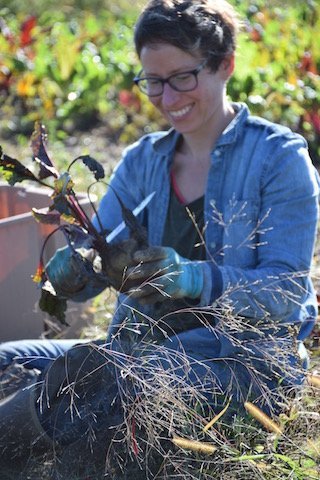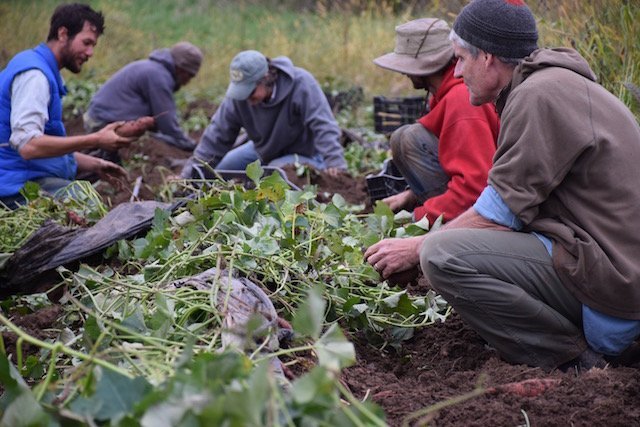
October Fifth
Saving Seed
Do you ever wonder where a farm like ours gets seeds? Where do they come from, what companies sell them? Are they organic? How do we choose which crops and varieties of each crop to grow? Selecting seeds is a process and it takes up a couple weeks our time in the winter carefully choosing varieties, getting the orders placed and logged into our spreadsheets. I still find it to be amazing that we can sit in the comfort our living room in January and pick and choose which varieites to grow. The little packages come in the mail one by one and so much potential comes from these little envelopes that come in the mail.
There are just a few seeds that we do save on the farm. We save our own garlic, shallot and a third of our potato seed. We have been growing and saving our own garlic seed for over 11 years. In 2005 I was working for Adam’s brother and took payment for part of my work in a few 5 and 10lb bags of garlic seed. I still remember the moment when I took the sacks of seeds into my arms. I remember the weight of them. It was like taking responsibility for a child. Now I had to do something with those seeds and take care of them.
We primarily grow 5 basic varieties of garlic seed now. Three of those varieites have been with us since the start of the farm. Armenian, German White and Asian Tempest are the hardy hardneck northern varieties that we have kept with us since the beginning. Year after year these varieties have proven themselves to us, staying true to their genes and yielding consistently beautiful garlic. We have eliminated a couple different varieties of garlic and have taken on a couple new ones as well. We also grow Russian Giant and Metechi that are a Marble Purple Stripe.
Saving your own seed feels empowering. It is like a renewable resource on our farm comparable to solar energy or collecting rain water or storing vegetables in a root cellar. It feels sustainable. There are years of Small Family Farm history now woven into these seeds. There are stories that we now have associated with each variety. We have begun to know their moods, flavors, growing patterns, and little quirky things about each variety that we either love or tolerate. Some people even say that with each year you save your own seed on your farm, that seed variety improves itself to your soil type and your latitude on the globe.
We also happen to really love eating garlic. Garlic is loaded in anti-oxidants, is good for boosting your immunity and has a long list of medicinal properties and health benefits. It is a strikingly attractive vegetable, stores very well and is possibly the least perishable crop we grow. Garlic is an extremely time consuming crop to cultivate with many steps throughout the year in the growing process that are crucial and must be done in a timely way. This is why when you see it in stores it has a high price per pound. Garlic is planted in the Fall and we plan to begin planting garlic around the end of October.
We plan to give garlic again the last two weeks of Summer Share deliveries. It will also be given in 1lb bags in the fall shares. We are honored to share this specialty crop with you. Thank you for being part of the story.
Sooo….What’s in the Box????
Butterkin Squash- These are the beautiful, creamy yellowish/orange-ish colored squash at the bottom of your box. Butterkins are a new variety of butternut are a wonderfully smooth and creamy squash with a dark orange flesh. Cut them in half, scoop the seeds out and lay the squash cut-side down in a 9×13 pan with about a half inch of water at the bottom of the pan. Bake them for about an hour at 350. After one hour, you will be able to scoop out all of the yellow/orange flesh.
Red Potatoes- 3lbs of red potatoes per member this week. While we were able to get these guys dug with the bed lifting machine, the soil was still terrifically muddy and we had a hard time getting all of the mud off of them. You’ll have a little cleaning project ahead of you before you cook these. Most of them had really good size and consistency. They say that dirty potatoes keep better than clean ones, so we justify not washing these guys!
Yellow Onions- A yellow onions to keep your home smelling like a home! They’re all cured down by now and we’ll continue to shell them out until then end of the season!
Jalapeno Pepper- One of these little guys per box. Jalapenos turn red as they ‘ripen’ near the end of the growing season. We’re nearing the end of the hot pepper season, possibly one more week still to go on these guys. You may have received a red Jalapeno.
Sweet Green, Yellow, Orange or Red Bell Peppers- Five bell peppers per member this week. You may have received red, orange, yellow or green peppers this week. We are also nearing the end of the sweet pepper season. We’ll continue to pick them as long as the frost holds off. We started picking them a little more aggressively, even if their color hadn’t turned completely. They have slowed down considerably with the amount that we are getting. Enjoy them while they last! Hopefully one more week to go on these guys!
Lunchbox Sweet Peppers- Everyone received about 1-2 of these little, small sweet peppers that could be mistaken for a hot pepper, but they are not hot. They usually come in red, yellow and orange colors. We grew these little guys last year for the first time and totally fell in love with them! Eat these for a snack raw, or cook with them like you would any other sweet bell pepper.
Brussels Sprouts- A very fun fall vegetable! We leave the Brussels sprouts on the stalk because it’s so much less work for us to not have to pick them all off for you. Plus, it’s fun for you to see how they grow! We worried that we had a near crop failure on the Brussels this year. So very many of them had rotten or black sprouts at the bottom of the plants that we had to snap off. We tried very hard to clean these up for you as best as we could, but there are still sprouts with some small black freckling. This has everything to do with so much moisture this year. You’ll have to sit with a paring knife and peel away a couple of the outer layers on some of these before you eat them. We like to just steam them and then toss them with butter, but I have seen some wonderful recipes where they are roasted in the oven coated in a little oil and salt. Try whatever sounds good to you!
Red Beets- Approx 1 lb of red beets per member this week. They varied in size quite a bit, so you may have received just a couple large beets, or a handful of small to medium ones.
Green Curly or Red Curly Kale- One bunch of green curly kale for everyone this week to make sure you have plenty of greens in your cooking!
Broccoli and/or Cauliflower- You may have received just one broccoli or cauliflower or you may have received two of them. If they were smaller in size, we were able to put two in the box. About 2/3 of the members received two pieces of either broccoli or cauliflower per box. We recommend using up your broccoli or cauliflower as soon as possible. These are highly perishable items and with all of the moisture this year, we were noticing that the broccoli has not been holding up as well.
Red Leaf Lettuce- One or two heads per member this week, depending on the size. Lettuce keeps best in a plastic bag in the fridge to preserve moisture.
Next Week’s Best Guess: carrots, red cabbage, cauliflower, broccoli, sweet potatoes, celeriac root, diakon radish, sweet bell peppers, winter squash, leeks, rutabaga
Recipes